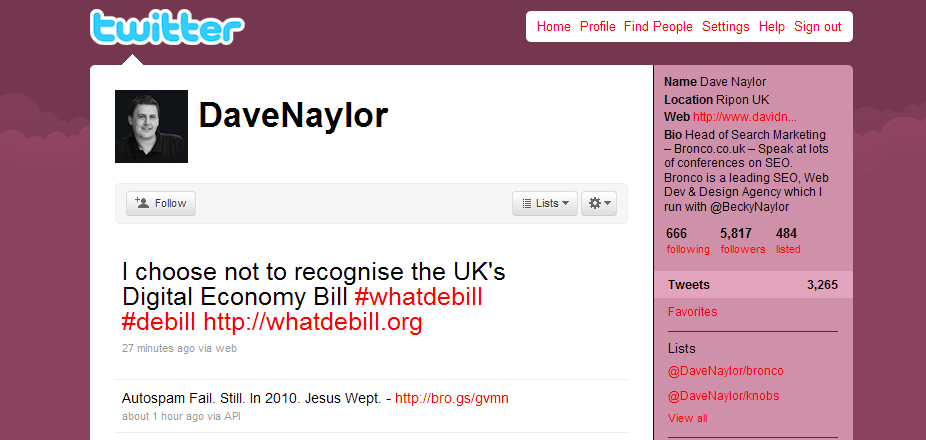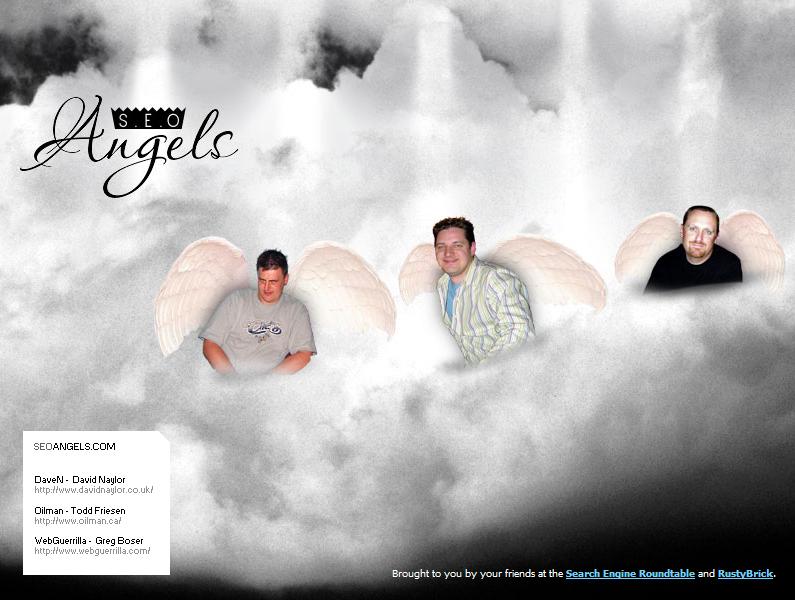 |
SEO 301 Redirects, Tools and EvangelistsGeneral SEO/SEM Ramblings |
| 8 April |
Dave Naylor is the Devil and here is the proof!
Lets start with the facts…
When it comes to an internet marketing mind, this man is an evil genius. I don’t think there is anyone in the industry that can argue that fact. Well today I noticed one of his Twitter updates @DaveNaylor where he happily talks about Jesus crying. There is no need to go into detail about why he would post about something like. It does appear as though he takes joy in the sorrow of one of the most popular religious figures in history. Next lets take a look at the number of people he is following – 666. Yes 666! A number that, for centuries has been a biblical reference to to devil.
The King James Version of the Bible translates:[9]
And that no man might buy or sell, save he that had the mark, or the name of the beast, or the number of his name. Here is wisdom. Let him that hath understanding count the number of the beast: for it is the number of a man; and his number is Six hundred threescore and six.
~Wikipedia – Number of the Beast
Next lets look at his Twitter background…a sky in the shade of red (it is more on the purple side but purple is a shade of red and blue). A red sky in the morning is something that has been associated as a bad omen for many years. Dare I quote another verse…
In the Bible (Matthew XVI: 2-3), Jesus is quoted, “When in evening, ye say, it will be fair weather: For the sky is red. And in the morning, it will be foul weather today; for the sky is red and lowering.” [5]
~Wikipedia – Red Sky at Morning
Finally, look at Dave’s Avatar. A black and white portrait with an evil grin. A demonic confidence is evident if you look into those dark eyes.
There is no question in my mind…Dave Naylor is the Devil


04/08/2010 11:01am EST This just in … Dave rejects any affiliation with the Devil and shows off his wings at http://seoangels.com/. You can see him there having a pint on a cloud with a couple other search marketing moguls Todd Friesen (@OilMan) and Greg Boser (@GregBoser). Take a close look at these heavenly internet guys. If they can make it in, I might actually have a chance. There is still something demonic about this image…I am not sure what it is but I think I may have nightmares tonight. Perhaps they are wolves in sheep’s clothing. Dave did tell me in confidence (if anyone was listening) that he is indeed the twin of Lucifer himself.

* DISCLAIMER *
I am not a religious man. My thoughts and perceptions of Dave are purely speculative. I have not witnessed nor have I heard of any capturing of souls or biting the heads off bats. I do not know of his mortality or if he sparkles or melts in sunlight. The jury is still out on Friesen and Boser. Go check out their sites and make your own judgments –
Dave Naylor – The Leading UK SEO Agency
Todd Friesen – Oilman | Recommended by 4 out of 5 people that recommend things
Greg Boser – 3 Dog Media, LLC
| 7 April |
Ok, so everyone knows how to edit their preferences and get up to 50 results per page on Bing.com. That’s no secret. But what if you are scraping bing using a script? Unless you are using some advanced curl techniques with cookie jars and cookie files, you have a lack of options. Well, just like google’s num=100 url query string, and yahoo’s n=100, you can add count=50 for bing.
Example:
http://www.bing.com/search?q=seo&count=50
Simple as that!

| 7 April |
Google Sitemaps now accept an image attribute Google Webmaster Blog. Images play a critical role in site structure and SEO. Proper indexing of your multimedia content is an important factor in the game of SEO. Sitemaps also play a critical role in the way a site is handled. In fact Matt Cutts has made a point in letting us know that sitemaps can be used as a tie breaker when trying to determining the most relevant source for duplicate content. The last point I want to focus on here is the fact of image ownership. If you are using the same image throughout your site and you know it is being cached in the Google Images results then you can only assume that the inclusion of the image in the site map will allow Google Images to better associate the proper page that is hosting that image and provide more relevant results in their result sets.
This new functionality becomes even more important if you have multiple images on a page and want to make sure the important ones get indexed. Couple that with the fact some images are served via Java. You can now make sure these are not overlookes the next time your page is indexed.
<?xml version=”1.0″ encoding=”UTF-8″?>
<urlset xmlns=”http://www.sitemaps.org/schemas/sitemap/0.9″
xmlns:image=”http://www.google.com/schemas/sitemap-image/1.1″>
<url>
<loc>http://SEO301.com/3</loc>
<image:image>
<image:loc>http://SEO301.com/ImageName.jpg</image:loc>
</image:image>
</url>
</urlset>
A sitemap can be easily submitted through Google Webmaster Tools (a free toolset available to all web owners). If you need help building out your sitemaps, visit the official Google sitemap forum.
| 6 April |
I was looking for a good WordPress 301 redirect plugin today and came accross the Simple 301 Redirect plugin from Scott Nelle. This plugin works great and bypasses any need for altering your htaccess file or entering your 301 redirects by hand. This plugin also works well as a URL shortening tool if you prefer to use your own domain instead of bit.ly on Twitter or other social media networks. Video demo coming soon…
httpv://www.youtube.com/watch?v=by6CfqjkteM
| 31 March |
Executing the Canonical Link Element
On page SEO301.com/canonical-link-element-2?session=oicu812 include the following code within the header…
<link rel=”canonical” href=”SEO301.com/canonical-link-element-2″/>
notice the closing “/”
About the Canonical Link Element
Similar to a 301 but executed on a live page is the canonical (preferred) link element. This page attribute allows you to fix those nasty query strings and multiple duplicate content issues on product pages. You basically tell the search engines”I know you are on this page but you should really be over here”. This standard was accepted by Google, Yahoo and Bing on February 12th 2009 and has quickly become an open industry standard. February 12th 2009 also marks the 200th anniversary of the birth of Charles Darwin. Much like his scientific theories, this marks the evolution of the web by enabling webmasters to control more of their content flow.
The canonical link element was introduced to handle one of the most important aspects of SEO and that is the handling of duplicate content.
Consider the following URL samples. Each of these pages could return unique content but in most cases will duplicate the home page. In face you can double these if you replicate your efforts on a secure server (https). In practice these results will generally produce the same page.
- www.seo301.com
- seo301.com
- www.seo301.com/
- seo301.com/
- www.seo301.com/index.html
- seo301.com/index.html
- www.seo301.com/Home.aspx
- seo301.com/Home.aspx
There are multiple ways you can go about fixing the issue above. The first is simple setting up the proper 301 redirects to make sure all incoming traffic is directed to the proper page. This assumes you have access to the server. In addition you should make sure your content management system (CMS) is configured in such a way that it produces clean content without much duplication. If you have a Google Webmastertools account you can actually select if you want the www or non-www version of your name to be the default. The other thing that Google tries to to is to break the ties between two pages by looking at your sitemap. It will use the sitemap as a directive in order to determine which page should get credit for the content. Obviously there is also the canonical link element that acts as a final determining factor of duplicate content.
The main reason canonical link elements will remain an integral part of the SEO method of operations is the fact that you can never control how people link to you. There will also be the unavoidable times when a client of yours is stuffing in session/affiliate IDs or populating insane query string paramaters in URL and refuse to fix them because of their “legacy back end coding standards”.
Supported Link Types of the Canonical Link Element
- absolute URLs
- relative URLs
- Cross sub-domain URLs
- Same page reference
- Slight differences in page content
- Chaining URLs (not advised)
- Empty hrefs (will point page to itself)
- Cross domain URLs
Note: On December 15th 2009 Google announced support of cross-domain canonical linking.
Matt Cutts on the Canonical Link Element
httpv://www.youtube.com/watch?v=Cm9onOGTgeM
| 26 March |
SEO 301 is a new blog created for exposing and detailing some of the most useful tools in the industry as well as some of the people that have dedicated their careers to making search marketing what it is today. Please be patient while we finish up our design and get everything up and running.
Thanks for visiting…
